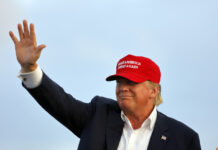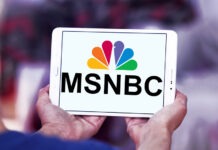Donald Trump Jr. created a significant uproar on social media on Saturday, November 1, 2025, by posting a crude message about his father’s contentious $300 million ballroom project on Instagram. The 47-year-old, who is the eldest son of President Donald Trump, shared a post by comedian Adam Carolla that used explicit language to defend the president against critics of the lavish project.
The Instagram post included Carolla’s X post, which stated: “The real Trump ballroom is the room he gives his balls in comparison to the leg crossing p—ies like Newsom and Obama.” The statement compared the president favorably to California Governor Gavin Newsom and former President Barack Obama, using explicit language to portray the political opponents as weak.
The comedian’s post displayed an image of a weary-looking Trump sitting with his knees apart, next to photos of former President Barack Obama and California Governor Gavin Newsom, both sitting with their legs crossed.
Trump Jr.’s decision to share this provocative content quickly attracted criticism from political analysts and social media users who found it inappropriate for the son of a sitting president. Although the post was removed from his Instagram story after several hours, screenshots of it were widely shared across social media platforms.
Donald Trump Jr. has been a prominent advocate for his father on social media, frequently sharing memes and messages in support of the 79-year-old president.
While his recent remarks about Trump’s private parts might be his most uncomfortable display of support to date, it is not the first time his online activities have caused a stir. In August, Don Jr. posted a partially AI-generated image showing Trump throwing a green dildo from the White House roof onto a WNBA basketball court. This image referenced past incidents involving green dildos being thrown at WNBA players.
Earlier, Don Jr. shared an AI-generated image of Trump wearing head-to-toe denim, a playful reference to Sydney Sweeney’s American Eagle ad, accompanied by an awkward caption.
“That Hanse… Um, Donald is so hot right now!!!” Don Jr. wrote, referencing Owen Wilson’s character in Zoolander.
The $300 million ballroom project, central to the controversy, has become a polarizing issue in President Trump’s current term. Planned for the White House grounds, the ballroom, known as the “Grand Presidential Hall,” is designed to host diplomatic receptions, state dinners, and official ceremonies.
The president has defended the significant expenditure, citing it as essential for the nation’s key residence. Trump told reporters that the current White House facilities are “outdated” and inadequate for hosting world leaders in a manner befitting America’s global standing.
President Trump stated during a press conference last month that the United States requires a space reflecting American greatness, emphasizing that visiting leaders should experience the nation’s best. He remarked that current facilities are outdated and from a different era.
The ballroom will span approximately 90,000 square feet and will feature crystal chandeliers from Europe, marble floors sourced from American suppliers, and advanced audiovisual technology. Architectural designs feature a grand space with 40-foot ceilings, gold-leaf accents, and accommodate up to 1,000 guests.
Despite the administration’s explanations, the project has met strong opposition from Democratic lawmakers and some fiscal conservatives within the Republican Party. Critics argue that the hefty price tag indicates misplaced priorities amid numerous pressures on the federal budget.
Representative Alexandria Ocasio-Cortez described the project as “grotesque excess” in a statement last week. “While working families struggle with rising costs, the president wants to spend $300 million on a ballroom that serves no purpose other than ego,” she said.
The controversy has extended beyond Washington, with editorial boards nationwide expressing opinions. The Washington Post published an article titled “A Ballroom the Country Doesn’t Need,” while The New York Times analyzed whether existing White House facilities truly require such extensive additions.
The ballroom debate has become a focal point in broader discussions on presidential priorities and government spending. Democrats have used the issue to demonstrate what they see as the administration’s disconnect from the concerns of ordinary Americans.
Political analysts suggest that the controversy could become a campaign issue as the 2026 midterm elections approach. Democratic candidates in competitive districts have already begun using the ballroom project in their early messaging, contrasting it with local infrastructure needs and social programs.
The president’s supporters, however, see the criticism as exaggerated and politically motivated. They argue that every administration invests in White House facilities and that maintaining prestigious venues for international diplomacy serves important national interests.
Despite the large price tag, the administration has emphasized that no taxpayer dollars will fund the ballroom construction. The entire $300 million budget is being covered by private donations from major corporations, according to a list published by Fortune online. The donor list includes some of America’s largest companies across various industries, including technology, finance, energy, and manufacturing. While supporters argue this private funding model eliminates concerns about government waste, critics contend that such significant corporate contributions create potential conflicts of interest and raise questions about access and influence at the White House. Ethics watchdog groups have called for greater transparency regarding any considerations these corporate donors might receive in exchange for their contributions to the presidential project.
Trump Jr.’s decision to amplify Carolla’s defense of the project indicates the first family has no plans to retreat from the controversy. The social media post, although crude, reflects the confrontational communication style associated with the Trump political brand.











